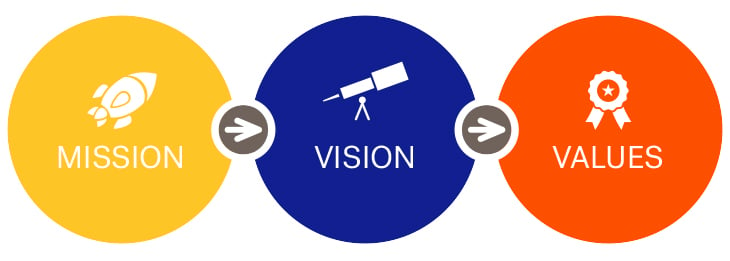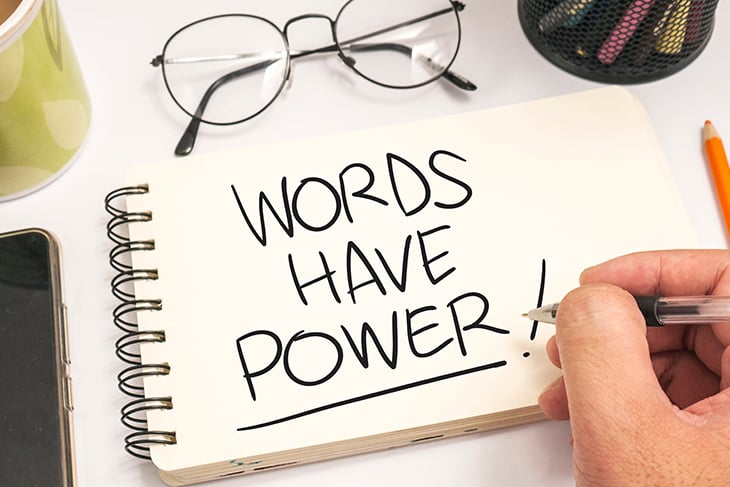Developing a marketing message sounds like it might be the simplest of tasks.
You might think it’s a few hours of work with the end result being words on a page or screen, but the truth is your marketing message is a big deal. There are so many things to consider when developing a strong marketing message.
The messaging development process is valuable and foundational to brand development because it:
- Forces you to think deeply about your target audience through research.
- Requires you to sincerely connect to the problems your customers are facing and empathize with their pain.
- Involves collaborative work on true brand differentiation.
Having this deep understanding ensures that you know how your product or service can best meet the needs of your customers.
In short, too many brands take time and energy developing communication that talks about who the company is and what they do. Your messaging needs to be laser-focused on your customer and their needs in order to be effective.
Following are 20 key components, things to consider and marketing message examples to get you started.
1. Plant Your Flag: Mission & Value Proposition
Does your marketing message reflect your mission and value promise to your customers? A company mission statement is an internal declaration of why a company exists. The best statements succinctly define the purpose and goals of an organization.
In addition, a company’s value proposition clearly conveys why a customer might choose your company over your competitors. The best ones have mission and value proposition at the core.
Take a simple pause. Reflect on your marketing message. Verify that it’s aligned every time with your mission and the value you bring to the marketplace.
2. Align with Your Company Goals
Successful companies know it’s important to set goals and revisit them often.
Those goals should be used throughout the company as a guiding light, including the development of your marketing strategy. The marketing message, a direct product of your marketing strategy, is the communication created to influence existing and potential customers to ultimately buy.
3. Take a Deep Dive into Your Target Market
You know your greatest source of information when developing a message? It comes from intimately knowing your target audience. When defining your target market, the simplest first step is to look at your existing customer base.
- Who are they?
- What are their likes and dislikes?
- Why do they buy products or services from you?
Check out this article on how to define your target market. The truth is you cannot realistically target everyone. A deep understanding of your audience ensures you are emotionally connected to their needs so you can build meaningful messaging. Want a great example? Take a cue from Always and their #LikeAGirl campaign. That’s a brand that gets its audience.
4. Research Competitor Messaging
A common misstep in developing a marketing message is overlooking the importance of researching the competition. Knowing your competition and what they stand for is critical to your success.
With constant monitoring of the competition, you can learn from their mistakes, document what works and effectively create differentiation in the marketplace. It’s important that you go into “spy-mode” at least 1-2 times per month to make sure you’re in the know. Set 30-60 minutes per month to review competitor websites and social channels. In addition, set Google Alerts for the competition so you know when they’re in the news.
5. Know Your Customers’ Problems Inside & Out
Do you know what keeps your customers up at night?
A marketing message that clearly and concisely speaks to the problem at hand—and the effective solution will likely win customers for your brand. Many of your customers’ product and service wants, needs and desires are simple. Make sure your message shows that you know the problem with a clear path to the perfect solution.
6. Speak Their Language: Write Like People Talk
Now more than ever, it is important to develop messages that align with the natural way consumers talk.
But, especially in business, it’s too easy to slip into using big words and technical jargon. So you end up with messaging that lacks emotion, doesn’t sound real and just doesn’t connect with your customers. Creating a great marketing message isn’t about sounding intelligent but more about how you intelligently convey your brand’s abilities in a way that makes customers take action.
7. Create an Emotional Connection
You’ve heard it for years … 95 percent of purchasing decisions take place in the subconscious mind. When your communication creates an emotional connection you’re definitely #winning. In a digital age, where consumers are seeing thousands of ads every day, an emotional bond is critical.
According to a Business Wire study in 2018, “Emotional Connection is the most predictive driving force behind brand purchasing decisions and the long-term loyalty of consumers.”
Fun Fact: Panera Bread ranked No. 4 on a top 5 list of brands who have successfully created a strong emotional connection with their customers. Check out who else made the list.
Consider these steps and marketing message examples when verifying that your message strategy is built to create an emotional connection with customers.
8. Present Your Solution to the Problem
If you’ve done your research and truly understand your target market, then you know the problems they face and how your product or service can assist. A creatively crafted message that articulates the solution to the problem is key to winning new customers. This includes clearly outlining the benefits (not just features) and how your solution will make life easier for your customers.
9. Take Full Advantage of Your Limited Headline Space
Unfortunately, the average consumer has gotten very good at skimming content to see if it is worthy of a full read.
According to a study conducted by Microsoft in 2018, the average human being now has the attention span of eight seconds.
Therefore, your headlines need to be genuinely attention-grabbing. The goal is to quickly draw attention to your brand, and that takes some creative time and determination to find a few words that stop consumers in their tracks.
10. Offer Something Invaluable in Return
Always consider the opportunity to offer something in return by allowing customers to essentially test-drive your product or service without a full commitment to purchase.
That could be a free trial, product sample or a service discount. This approach shows your commitment to what your brand has to offer, as well as those you wish to experience it.
11. Consider Using Humor
If it makes sense to infuse humor into your marketing message, then absolutely consider it.
Some of the most memorable ones are those that have made us laugh out loud, right?
The truth is that humor sells, and when people are laughing they are likely sharing that laughter through word of mouth or via their social network. Take a peek at these marketing message examples that show how you can use humor in your branding.
12. Be Original: Showcase a Differentiated Brand
Companies who are in tune with the competition are effectively finding ways to differentiate their brand. Developing core messages that showcase why you are unique will help your company stand out.
Does your message convey why your brand is different? Here are some marketing message examples and ideas on how you can create brand differentiation.
Read our other related article: 8 Key Reasons Why Branding Is Important & 1 Why It Isn't
13. Employ a Different Message for Different Channels
A good marketing strategy consists of a variety of marketing channels, like your website, social media, pay-per-click, SEO, events and print. It’s important to stay on brand when developing marketing messages from channel to channel; however, that doesn’t mean creating the same message for all mediums.
Knowing the audience you’re targeting in that channel and developing a unique message that is consistent, yet different, is critical to the success of your overall strategy.
14. Tell Your Authentic Brand Story
When you think of your brand like a story, you can very quickly identify the main character (your customer) and what they want. As with every story, there’s a villian and with brand messaging that is likely the problem your customers are facing. A well-crafted message will position itself as a guide to solving the problem. The primary job of the brand is to lift customers to hero status.
Here are three reasons why brand storytelling is the future of marketing.
15. Define Your Brand Personality
To ensure your communication is authentic, think of your brand as a person.
- How would that person talk with customers and potential customers?
- How would they make people feel?
Defining and remaining true to your brand personality is important to maintaining consistency in your messaging and also helps ensure you are connecting with prospects on a personal level.
16. Market in the Moment
Today’s marketing landscape requires relevancy and forward thinking. Moment marketing is identifying the right marketing message for the right audience at exactly the right time. Today’s consumer is complex and moves quickly across channels, so using predictive analytics to identify potential opportunities and being willing to capitalize on things you could never prepare for will aid in the development of “right place, right time” communication. Here are some moment marketing messages examples.
17. Create a Genuine Sense of Urgency
The use of urgency and scarcity are common communication tactics used in many industries. Purchase anxiety is a real thing and important for marketers to understand when developing consumer messaging.
Your goal is to get a potential buyer to act quickly.
Terms like “in high demand,” “only 2 left” or “deal of the day”, or showcasing real results from real customers, can create a sense of urgency with your target audience. Use caution with urgency and remain truthful. Don’t miss this marketing message examples that use urgency to encourage buying.
18. Use Persuasive Words
Being persuasive with your words is easier said than done. It’s definitely a balance between art and science and requires you to understand those words that trigger the human brain to act. So, when developing your message, make sure to use your verbs and limit the adjectives.
Some studies show that adjectives can reduce the power of your message, while others state the best writing involves the creative use of adjectives. So, what is the truth when developing your messaging? The real answer is to consider these three rules:
- Does the meaning of the sentence change when you leave the adjective out? If not, skip it.
- If you can replace an adjective with a stronger noun, do it.
- Limit the number of adjectives before a noun.
Check out the five most persuasive words in the dictionary.
19. Consider Customer Stories and Testimonials
According to Nielsen research, “92% of people will trust a recommendation from a peer, and 70% of people will trust a recommendation from someone they don’t even know.”
Now that’s powerful. Consumers crave the feedback of other consumers to help them make buying decisions. If you can utilize the feedback and stories of your customers to engage new buyers, it’s a no-brainer. Check out these brands using customer stories to create brand engagement.
20. Keep It Personal
In a data-driven marketing universe, consumers expect you to know who they are, what they’ve purchased and what they might like to purchase in the future.
Everyone has received that mailer from the company they’re already doing business with that offers the new customer discount—it’s insulting. Your marketing message needs to be as personalized as possible. Use your customer’s name, segment your mailing lists to create tailored messages, and reward loyal customers. Make sure they know that you know who they are and that you value them.
Does Your Marketing Message Pass the Test?
Developing a strong, unique marketing message takes time and a lot of thought. The focus is always on your target audience and the goal is to communicate value.
- Consumers are looking for solutions. Communicate clearly how you can meet their needs. Make it about them.
- Talk directly to your target audience. Make them feel special by validating the fact that you know who they are.
- Be real and authentic. Tell your story in a way that creates an emotional connection.
- Use what you’ve learned in Psychology 101. Use a persuasive, active tone with customer testimonials to support it.
- Be marketing-channel aware. Different messages are needed in different places, so build your messaging plan accordingly.
- Make sure the brand message clearly states how you’re different. Your goal is to stand out from the competition.
- Make sure marketing messages align with your mission, vision, values and company goals. This helps make sure your internal team and their marketing orders match your marketing message strategy.
Your marketing message is a big deal. Your goal is to rise above the noise. To make sure your brand tells a unique and impactful story. Using this guide as a filter or reference will help ensure you have the best message ever.











